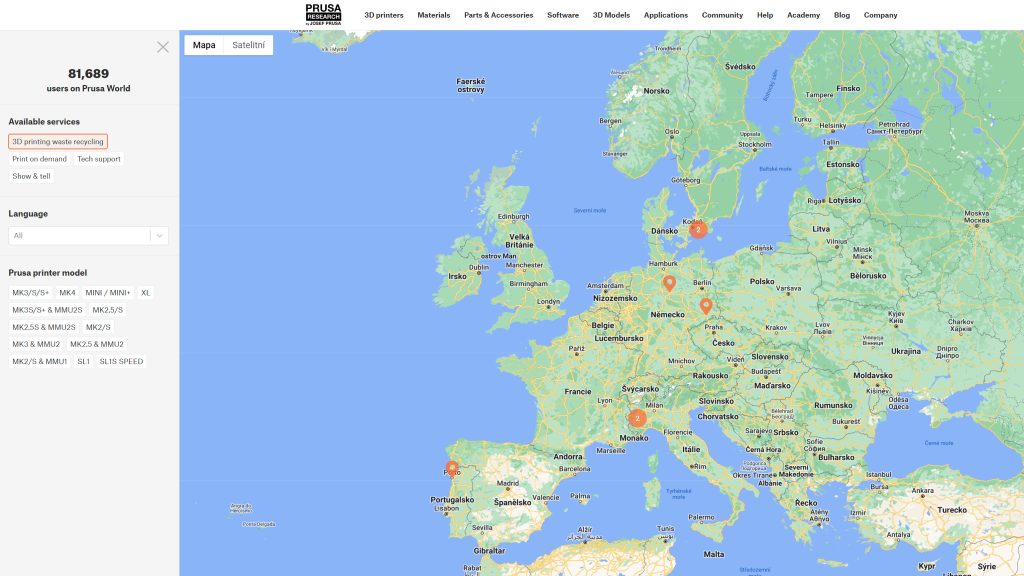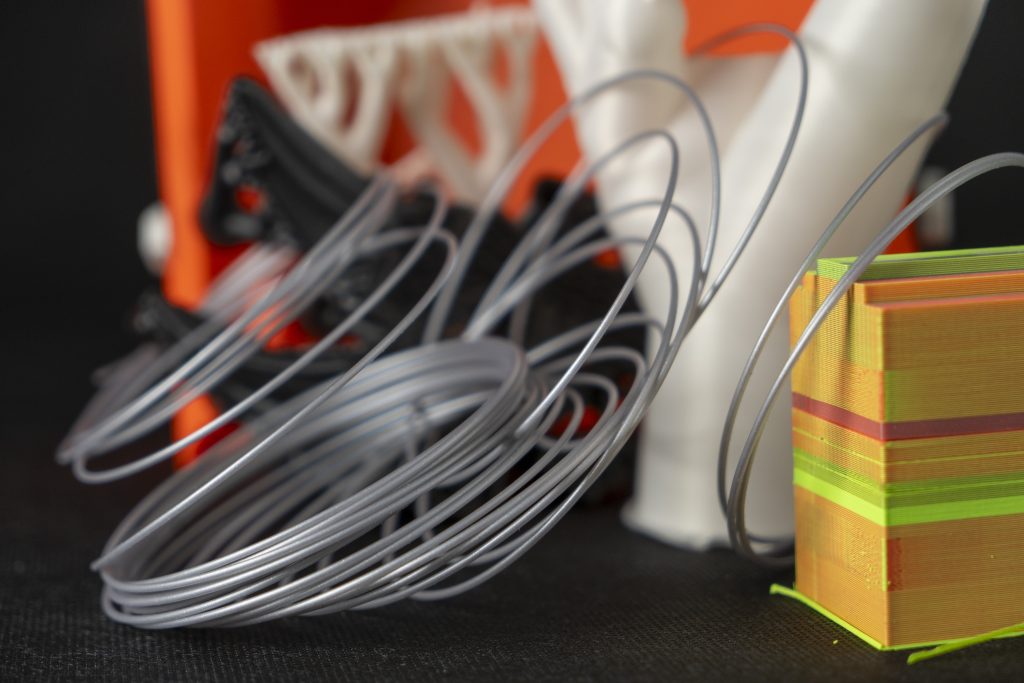Last year, when introducing our sustainability strategy we asked you what issues you perceive as the most important. By far the most frequent feedback, more than 30% of all the replies was about “recycling useless prints and leftover filament”. On a global scale, this topic is quite a challenge, but we think we finally got off to a good start!
Obviously, collecting and shipping small amounts of 3D print waste dispersed in workshops and households around the world would make no sense, economically or environmentally. Therefore, any sensible solution in this regard must exist on a local level.
While we don’t have a capacity to create such a global, decentralized network of recycling hubs ourselves, we can at least use our resources and global reach to inform, connect, and organize the worldwide community, so everyone can find a suitable recycling option within a reasonable distance.
Prusa World Map filter
For this purpose, we have reused and improved our older Prusa World Map project, which now features small-scale plastic recycling projects around the world.
The map includes both projects from our 3D printing community and the Precious Plastic community. Some of the projects even make their own filaments from plastic waste, for example, Recycling Fabrik from Germany or Printeriordesigns from the USA.
For the time being, the projects are still (literally) few and far between, but we are already filling the blank spots on the map. Also, we have partnered with experts on small-scale recycling known as Precious Plastic to utilize their existing know-how and contacts. However, we will need your help as well, to get this whole recycling network up and running!
With the newly added map filter, you will be able to locate your nearest plastic recycling solution point. You will see what is that particular recycling project about, what materials they need, and how to contact them. Feel free to browse the Prusa World Map to learn more.
Speaking about material – from the point of view of us, 3D printer users, the 3D print plastic waste is just an inconvenience we want to get rid of. However, for many of the small recycling businesses, it is actually a valuable resource. Compared to the content of a regular recycling bin, the 3D print plastic waste is homogeneous, clean, and with a more-or-less predictable composition (at least when collected first-hand and on a small scale). Therefore, connecting the recyclers with the 3D printing community has the potential of a great match.
Adding new places to the map
If you’re running your own business that includes recycling 3D printing waste, go ahead and add yourself to the map – the instructions are available here. The process is very quick and simple (and we are always here to help you).
Please only add a business/recycling point if you really act on their behalf (to minimize misunderstandings, outdated info, etc.).
If you know about a place but do not represent them, please just let us know through this simple form and we will take care of the communication ourselves. Thank you in advance!
Introduction of Precious Plastic
So, who are these Precious Plastic guys we keep mentioning? Let’s briefly introduce them: Precious Plastic is an organization that focuses solely on plastic waste micro-recycling – they manage the global community of local recyclers in 100+ countries around the world. On the other hand, our main business is making 3D printers, filaments, and resins. Although we have many more small-scale projects running inside the company, global 3D print waste management is a problem on a whole other level.
Examples of Precious Plastic projects
Smashing Plastic from Italy develops designs and solutions for upcycling 3D print waste in durable design furniture. They collect and shred plastic (mostly PLA and PETG) and use it for creating various pieces of furniture and household items. Check out what they can make from your 3D print waste! See their profile on the Prusa World Map or FB page.
 |
 |
Remix Plastic is a small project from New Zealand, collecting PLA scraps from local maker spaces, and shredding and melting them into various colored sheets. These sheets are then laser-cut into earrings and other small jewelry and accessories. See the profile on the Prusa World Map or their webpage.
 |
 |
Viva Lab from Portugal is a multi-focus fabrication laboratory with 4 years of experience in 3D printing waste recycling. They focus mostly on PLA and ABS but can handle other materials too. Viva Lab collects material from local maker spaces, schools, and individual makers to create a variety of products, ranging from yo-yos and earrings to cupboard doors. See their profile on the Prusa World Map or their webpage.
 |
 |
PLA and biodegradability
Wait, why do we bother about recycling so much – PLA as the most common filament material is biodegradable, so we can just toss it into garden compost, right?
Well, not quite. First, the material is processable only in industrial composting plants. Secondly, on a large scale, it is difficult to identify the material properly (and prevent mixup with PETG, for example). Composting plants willing to process PLA are practically non-existent. According to available studies, PLA does not decompose on domestic compost and is not recommended to be added to it, e.g. because of the release of microplastics. That is why we stopped labeling our PLA filaments as biodegradable in 2022.
Reduce, reuse, and recycle
Last but not least, please keep in mind that the best waste management is minimizing the waste output in the first place. That means thinking twice about the slicer settings and print optimizing (for example not using excess infill density or supports), etc., and also printing meaningful things (well, at least sometimes 😉 ). You can find some inspiration for example in one of our older articles or when looking at contributions to the Printables.com Repair and spare parts contests.
Happy printing!








I'm excited to see some representation of this effort on the other side of the pond. I've been storing failed prints and spool remnants for years now, hoping to have some way to reuse this material or, at a minimum, send it somewhere to be reused.
So I was delighted to see they've got folks in North America. https://www.preciousplastic-usa.com/
I've been saving mine for years too, haha! I'll check out the links to preciousplastics, thanks!
Kudos to Prusa's innovative move toward local 3D print waste recycling solutions! The Prusa World Map initiative, in partnership with Precious Plastic, highlights key recycling hubs globally. It's a pivotal step in addressing a major concern of the 3D printing community. From ZetarVac. https://zetarvac.com
At Gateway Express Clinic, we are dedicated to offering comprehensive healthcare services that prioritize your well-being. As Gateway Primary Care Clinic, we take pride in delivering patient-centered care in a convenient and welcoming setting. Your health is our primary focus, and we look forward to serving you with professionalism and compassion.
So many dead printables accounts in my area and I feel like a bunch of people just clicked a button when they signed up to say they were into waste recycling but in reality their not.
Why do you use Google Maps for this and not OpenStreetMap?
Maybe a home-scale Prusa print shredder + filament extruder could be a potential product in the future?
Hello, first off, hats off to you for these efforts. However, the text could use some nuances. The statements you're making are very country-specific. For example, the Dutch government has published many research papers on the recycling of bioplastics like PLA, and their future strategies, many of which contrast with what you’re stating here.
Statements like, "Composting plants willing to process PLA are practically non-existent," don’t apply globally. Here in the Netherlands, we have dedicated bioplastic composting plants (which receive bioplastics from other facilities), as well as government policies on recycling PLA and strategies for a circular supply chain. All of this information is published and available for those who want to learn more. (i could provide some links, but not sure if allowed here).
In short, don’t ship your trash around the world when your government has already provided local solutions to disgard your materials.